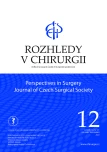Permanent intravenous access in experimental surgery – our experience
Authors:
R. Pálek 1,2; J. Rosendorf 1,2; S. Šarčevič 1,2; J. Ševčík 2; O. Brzoň 2; L. Kepková 2; P. Krystl 2; M. Brousil 2; L. Červenková 2; V. Třeška 2; V. Liška 1,2
Authors‘ workplace:
Chirurgická klinika, Fakultní nemocnice Plzeň a lékařská fakulta Univerzity Karlovy v Plzni
1; Biomedicínské centrum, Lékařská fakulta Univerzity Karlovy v Plzni
2
Published in:
Rozhl. Chir., 2022, roč. 101, č. 12, s. 577-583.
Category:
Original articles
doi:
https://doi.org/10.33699/PIS.2022.101.12.57–583
Overview
Introduction: Permanent intravenous access is usually required in pigs used for surgical experiments, not only to enable repeated blood sample collections. The aim of this study was to evaluate the patency and complications of vascular access ports (VAP) implanted in pigs included in different surgical experiments.
Methods: VAPs were implanted via the external jugular vein in a total of 211 pigs from 7 different experiments. All observed complications were retrospectively evaluated.
Results: No complications were observed in 157 animals (74.4%). Complications of the least severity were edema or seroma around the port which were observed in 12 (5.7%) and 3 (1.4%) animals, respectively. Temporary problems with aspiration of blood via the port occurred in 13 animals (6.2%). The most severe complications which prevented the use of the VAP for aspiration and application were recorded in 26 animals (12.3%). These complications included: abscess formation around the port (12 animals), skin necrosis over the port (2 animals), partial wound dehiscence (2 animals) and loss of the VAP function due to an unspecified cause (10 animals). Removal of the VAP was not needed in any of the animals and none of the animals had to be excluded from the experiment due to the complications. The VAP can also be used for safe administration of iodine contrast agent during CT examination.
Conclusion: Despite the observed complications the VAP is suitable as permanent intravenous access in pigs used for surgical experiments. This method helps to minimize the stress of the animals in the postoperative period and to reduce the number of experimental animals.
Keywords:
experimental surgery – complications – domestic pig – vascular access port – intravenous access
Sources
1. Swindle MM. Swine in the laboratory: Surgery, anesthesia, imaging, and experimental technique. 3rd edition, CRC Press 2016.
2. Brown JR, Tyeryar EA, Harrington DG, et al. Femoral venipuncture for repeated blood sampling in miniature swine. Lab Anim Sci. 1978;28(3):339–342.
3. Ege CA, Parra NC, Johnson TE. Noninfectious complications due to vascular access ports (VAPs) in Yucatan minipigs (Sus scrofa domestica). J Am Assoc Lab Anim Sci. 2006;45(6):27–34.
4. Moritz MW, Dawe EJ, Holliday JF, et al. Chronic central vein catheterization for intraoperative and long-term venous access in swine. Lab Anim Sci. 1989;39(2):153–155.
5. Smith DM, Lieberman RP, Stribley JA, et al. Chronic catheterization of the inferior vena cava in Yucatan miniature swine. Lab Anim Sci. 1992;42(6):602–606.
6. Swindle MM, Nolan T, Jacobson A, et al. Vascular access port (VAP) usage in large animal species. Contemp Top Lab Anim Sci. 2005;44(3):7–17.
7. Chuang M, Orvieto M, Laven B, et al. Comparison of external catheters with subcutaneous vascular access ports for chronic vascular access in a porcine model. Contemp Top Lab Anim Sci. 2005;44(2):24–27.
8. Henderson KK, Mokelke EA, Turk JR, et al. Maintaining patency and asepsis of vascular access ports in Yucatan miniature swine. Contemp Top Lab Anim Sci. 2003;42(6):28–32.
9. Moroni M, Coolbaugh TV, Mitchell JM, et al. Vascular access port implantation and serial blood sampling in a Gottingen minipig (Sus scrofa domestica) model of acute radiation injury. J Am Assoc Lab Anim Sci. 2011;50(1):65–72.
10. Rosendorf J, Klicova M, Cervenkova L, et al. Double-layered nanofibrous patch for prevention of anastomotic leakage and peritoneal adhesions, experimental study. In Vivo 2021;35(2):731–741. doi:10.21873/invivo.12314.
11. Rosendorf J, Horakova J, Klicova M, et al. Experimental fortification of intestinal anastomoses with nanofibrous materials in a large animal model. Sci Rep. 2020;10(1):1134. doi:10.1038/s41598- 020-58113-4.
12. Rosendorf J, Klicova M, Cervenkova L, et al. Reinforcement of colonic anastomosis with improved ultrafine nanofibrous patch: experiment on pig. Biomedicines 2021;9(2):102. doi:10.3390/biomedicines9020102.
13. Palek R, Jonasova A, Rosendorf J, et al. Allogeneic venous grafts of different origin used for portal vein reconstruction after pancreaticoduodenectomy – experimental study. Anticancer Res. 2019;39(12):6603–6620. doi:10.21873/ anticanres.13876.
14. Palek R, Rosendorf J, Maleckova A, et al. Influence of mesenchymal stem cell administration on the outcome of partial liver resection in a porcine model of sinusoidal obstruction syndrome. Anticancer Res. 2020;40(12):6817–6833. doi:10.21873/anticanres.14704.
15. Machat S, Eisenhuber E, Pfarl G, et al. Complications of central venous port systems: a pictorial review. Insights Imaging 2019 Aug 28;10(1):86. doi:10.1186/ s13244-019-0770-2.
16. Cowart RP, Payne JT, Turk JR, et al. Factors optimizing the use of subcutaneous vascular access ports in weaned pigs. Contemp Top Lab Anim Sci. 1999;38(3):67–70.
17. Moroni M, Coolbaugh TV, Mitchell JM, et al. Vascular access port implantation and serial blood sampling in a Gottingen minipig (Sus scrofa domestica) model of acute radiation injury. J Am Assoc Lab Anim Sci. 201;50(1):65–72.
Labels
Surgery Orthopaedics Trauma surgeryArticle was published in
Perspectives in Surgery

2022 Issue 12
Most read in this issue
- Domestic pig head and neck arteries from the viewpoint of imaging methods and experimental surgery
- Chylothorax treatment with thoracic duct embolization
- Introducing in vivo pancreatic cancer models for the study of new therapeutic regimens
- Permanent intravenous access in experimental surgery – our experience
